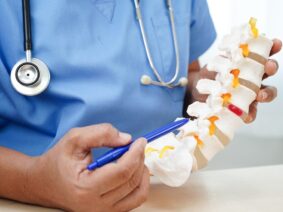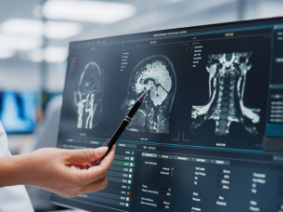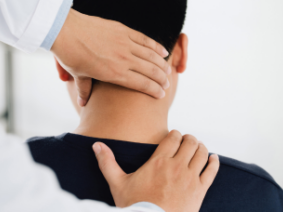What is spinal stenosis?
Spinal stenosis is a narrowing of the spinal canal or the space the spinal nerves travel through. As a result, pressure may be placed on the nerves and cause symptoms such as pain, numbness and tingling.
Spinal stenosis is classified based on where along the spine the narrowing is occurring. There are two main types: cervical (neck) and lumbar (low back). Lumbar is the most common kind of spinal stenosis.
What causes spinal stenosis?
While some patients are born with narrow spinal openings, spinal stenosis is typically due to any of the following:
- A herniated disc, where the center of the disc that acts as a cushion between the vertebrae leaks and presses on the spinal cord or nerves
- An overgrowth of bone in which osteoarthritis causes bone spurs to form and grow into the spinal canal
- Injury to the spine due to a motor vehicle accident or other trauma that can result in swelling, dislocation or fracture of the bone and tissues of the spine
- Thickened ligaments (the bands of tissue that hold bones together) that become fibrous and stiff over time, and bulge into the spinal canal
- Tumor growth that can form in the canal itself, the membranes that cover the canal, or in the open space between the vertebrae and spinal cord, resulting in pressure on the cord or nerves
What are the symptoms?
Symptoms usually start off gradually and then worsen over time. Symptoms can also vary depending on the type of spinal stenosis a patient has. It is important to note that not everyone who has spinal stenosis will show symptoms.
Cervical Stenosis of the Spinal Canal or Openings
- Difficulty with walking or balance
- Issues with bowel and bladder function (in severe cases)
- Neck pain
- Tingling, weakness or numbness in the arm, hand, leg or foot
Lumbar Stenosis of the Spinal Canal or Openings
- Back pain
- Cramping or pain in the legs after walking, standing or sitting for long periods of time that eases when bending forward or sitting
- Numbness, tingling or weakness in the foot or leg
How is spinal stenosis diagnosed?
Following a detailed medical history, explanation of symptoms and a thorough examination, a physician may recommend imaging tests to confirm a diagnosis, including:
- Computerized tomography (CT) scan or CT myelogram to show any disc herniation, tumors or bone spurs using numerous X-rays that create cross-sectional images of the spine
- Magnetic resonance imaging (MRI) scan that uses a magnet and radio waves to find where the nerve pressure is happening, as well as any damage to the spinal discs, ligaments or tumor development
- X-ray for any changes in the bone, such as the formation of a bone spur
How is it treated?
Treatments for spinal stenosis depend on the location and severity of symptoms. They include:
Medications
There are a few different types of medication a physician may prescribe to ease mild symptoms, such as:
- Anti-seizure medications to reduce pain caused by nerves that are damaged
- Certain antidepressants to alleviate chronic pain
- Opioids for short-term pain relief
- Over-the-counter pain relievers (for a short period of time), including acetaminophen (e.g., Tylenol), ibuprofen (Advil) or naproxen (e.g., Aleve)
Physical Therapy
Physical therapy may be suggested for patients who have become less active due to pain and have muscle weakness as a result (which also causes pain). With physical therapy, patients with spinal stenosis may:
- Build up endurance and strength
- Improve balance
- Keep the spine stable and flexible
Corticosteroid Injections
A corticosteroid injection directly into the spot where the nerve is pinched and inflamed may relieve pain in some patients. However, it can only be performed a few times a year due to side effects, such as weakening of nearby connective tissues and bone.
Percutaneous Image-Guided Lumbar Decompression
Percutaneous image-guided lumbar decompression (PILD) is a procedure in which needle-like instruments are utilized to remove some of the thickened ligament in the lumbar spine that is causing the space in the canal to narrow and nerve impingement (pinching). PILD may be an ideal option for patients with other conditions or who have a high risk of developing complications from surgery.
Surgery
Surgery is performed for spinal stenosis when symptoms are severe, or all other treatment modalities have failed. Surgical options can include:
- Laminectomy, where the protective covering of the spine (lamina) is removed to create more space and ease the pressure on the nerves
- Laminoplasty, where a hinge is created on the lamina and metal hardware is inserted to bridge the gap in the opened portion of the spine (only for cervical stenosis)
- Laminotomy, a procedure in which only a part of the lamina is removed to alleviate pressure in a particular spot
- Minimally invasive spine surgery (MISS), procedures designed to remove the lamina or bone using techniques that cause minimal damage to the surrounding tissues
For more information about spinal stenosis or to schedule an appointment with a specialist, contact us today.



